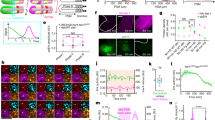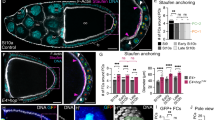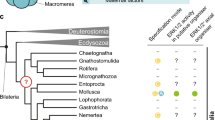Abstract
SEGMENTATION of the Drosophila embryo depends on a hierarchy of interactions among the maternal and zygotic genes in the early embryo (see refs 1–3 for reviews). The anterior region is organized maternally by the bicoid (bcd) gene product, which forms a concentration gradient in the anterior half of the embyro4–6. The gap genes are also involved in establishing the body plan, with hunchback (hb) being expressed both maternally and zygotically7,10. Zygotic expression of hb is directly activated by the bcd gene product, leading to a subdivision of the embryo into an anterior half expressing zygotically provided hb protein and a posterior half that does not. A similar effect on maternally provided hb protein is caused by the gene nanos, which represses the translation of maternally provided transcripts in the posterior half. This regulation of hb protein is a prerequisite for abdomen development, because the presence of hb protein in the posterior half represses posterior segmentation14,17,18. This repression mechanism suggests that posterior segmentation might not directly depend on maternal positional cues, but be solely organized at the zygotic level. Here we report further evidence to support this hypothesis and show that the hb protein itself is crucially involved in organizing abdominal segmentation. Differential concentrations of hb protein determine the anterior and posterior borders of expression of the gap gene Krüppel (Kr) and the anterior border of the gap gene knirps (kni), thus defining three positional values. These regulatory pathways are controlled in a redundant way, in part by bcd and in part by the maternal hb gene product.
This is a preview of subscription content, access via your institution
Access options
Subscribe to this journal
Receive 51 print issues and online access
$199.00 per year
only $3.90 per issue
Buy this article
- Purchase on Springer Link
- Instant access to full article PDF
Prices may be subject to local taxes which are calculated during checkout
Similar content being viewed by others
References
Akam, M. Development 101, 1–22 (1987).
Ingham, P. Nature 335, 25–34 (1988).
Nüsslein-Volhard, C., Frohnhöfer, H. G. & Lehmann, R. Science 238, 1675–1681 (1987).
Frohnhöfer, H. G. & Nüsslein-Volhard, C. Nature 324, 120–125 (1986).
Driever, W. & Nüsslein-Volhard, C. Cell 54, 83–93 (1988).
Driever, W. & Nüsslein-Volhard, C. Cell 54, 95–104 (1988).
Tautz, D. Nature 332, 281–284 (1988).
Jäckle, H., Tautz, D., Schuh, E., Seifert, E. & Lehmann, R. Nature 324, 668–670 (1986).
Gaul, U. & Jäckle, H. Cell 51, 549–555 (1987).
Lehmann, R. & Nüsslein-Volhard, C. Devl Biology 119, 402–417 (1987).
Nüsslein-Volhard, C. Roux's Arch. dev. Biol. 183, 249–268 (1977).
Wharton, R. P. & Struhl, G. Cell 59, 881–892 (1989).
Lehmann, R. & Nüsslein-Volhard, C. Cell 47, 141–152 (1986).
Struhl, G. Nature 338, 741–744 (1989).
Pankratz, M., Hoch, M., Seifert, E. & Jäckle, H. Nature 341, 337–340 (1989).
Lehmann, R. & Frohnhöfer, H. G. Development (Suppl.) 107, 21–29 (1989).
Hülskamp, M., Schröder, C., Pfeifle, C., Jäckle, H. & Tautz, D. Nature 338, 629–632 (1989).
Irish, V., Lehmann, R. & Akam, M. Nature 338, 646–648 (1989).
Sander, K. Adv. Insect Physiol. 12, 125–238 (1976).
Elkins, T., Zinn, K., McAllister, L., Hoffmann, F. M. & Goodman, C. S. Cell 60, 565–575 (1990).
Tautz, D. & Pfeifle, C. Chromosoma 98, 81–85 (1989).
Busson, D., Gans, M., Komitopoulou, K. & Masson, M. Genetics 105, 309–325 (1983).
Nauber, U. et al. Nature 336, 489–492 (1988).
Schröder, C., Tautz D., Seifert, E. & Jäckle, H. EMBO J. 7, 2881–2887 (1988).
Driever, W. & Nüsslein-Volhard, C. Nature 337, 138–143 (1989).
Struhl, G., Struhl, K. & Macdonald, P. Cell 57, 1259–1273 (1989).
Struhl, G. Ciba Foundn Symp. 144 (eds Evered, D. & Marsh, J.) 65–86 (Wiley, Chichester, 1989).
Author information
Authors and Affiliations
Rights and permissions
About this article
Cite this article
Hülskamp , M., Pfeifle, C. & Tautz, D. A morphogenetic gradient of hunchback protein organizes the expression of the gap genes Krüppel and knirps in the early Drosophila embryo. Nature 346, 577–580 (1990). https://doi.org/10.1038/346577a0
Received:
Accepted:
Published:
Issue Date:
DOI: https://doi.org/10.1038/346577a0
This article is cited by
-
Differential regulation of alternative promoters emerges from unified kinetics of enhancer-promoter interaction
Nature Communications (2022)
-
Bayesian model selection for the Drosophila gap gene network
BMC Bioinformatics (2019)
-
MARZ: an algorithm to combinatorially analyze gapped n-mer models of transcription factor binding
BMC Bioinformatics (2015)
-
Analysis of functional importance of binding sites in the Drosophila gap gene network model
BMC Genomics (2015)
-
Temporal and spatial dynamics of scaling-specific features of a gene regulatory network in Drosophila
Nature Communications (2015)
Comments
By submitting a comment you agree to abide by our Terms and Community Guidelines. If you find something abusive or that does not comply with our terms or guidelines please flag it as inappropriate.



